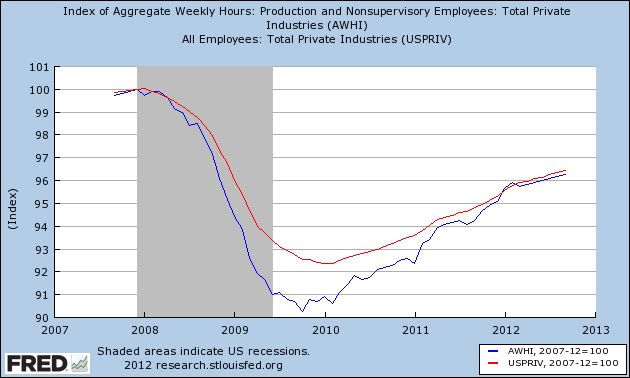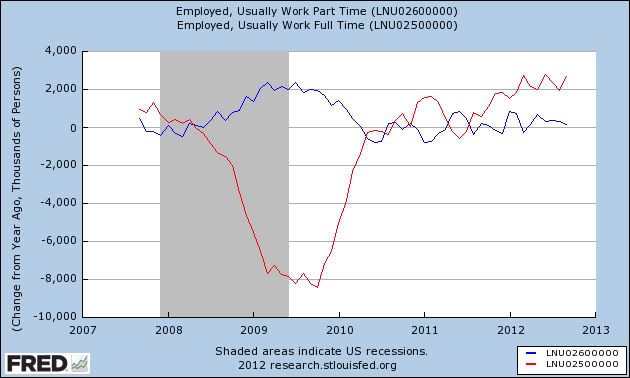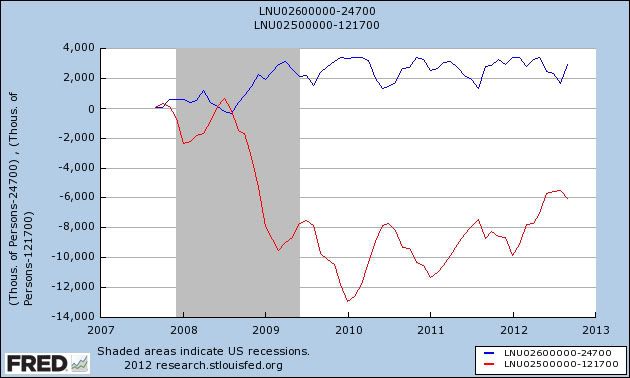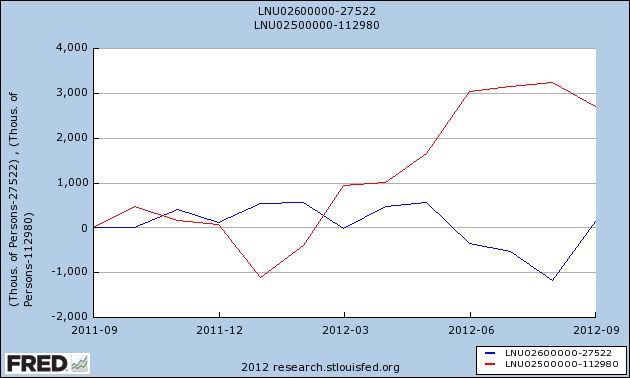- by New Deal democrat
One of the tropes trotted out to disregard Friday's good unemployment report is that all of the jobs created were part time jobs. It is claimed that the economy is not creating any full time jobs. This could hardly be further from the truth.
One relationship I have been harping about for a couple of years now is the relatinship between aggregate hours worked in the economy vs. the number of jobs in the economy. It is thought that the former is a series the NBER consults to verify whether the economy is expanding or contracting. As I've pointed out many times, measured in terms of hours, the economy underwent a far more serious contraction than in terms of simply jobs lost. Since bottoming in 2009, aggregate hours worked had increased consistently more strongly than the number of jobs added to the economy, as shown in the graph below:

Note that this year, aggregate hours finally made up their shortfall. Since that time, aggregate hours worked and the number of payrolls added to the economy have matched quite closely.
This suggests that full time workers, who had had their hours cut during the recession, had their hours increased again before their employers hired new employees. If so, then coming out of the recessin, as part time workers became full time, hours would increase faster than new jobs would open up. Finally, this year, the number of full time would be created without the interim step of part time hours, so we should see part time jobs stall out relative to full time time jobs.
And that's exactly what has happened. Below is a graph of the YoY change in part time jobs (blue) and full time jobs (red). The series are measure YoY because the data is not seasonally adjusted, so the YoY measure avoids the seasonal distortions:

Notice that the number of part time jobs in the economy actually rose significantly during the recession while, naturally, the number of full time jobs fell far more. This is pretty dispositive evidence that many workers' full time jobs were cut down into part time jobs during the recession. Since that time, the number of part time jobs added YoY has tended towards zero, while the number of full time jobs added has grown consistently.
Here's the same data, but measured as the total number of part time jobs (red) and full time jobs (red), normed to zero just before the beginning of the last recession five years ago:

Remember that the data is not seasonally adjusted. Notice that in the longer view it's pretty clear that the recovery in full time jobs has actually accelerated. So now let's zoom in on the past year. This is the same data as directly above, but now normed to zero as of one year ago:

Since September of last year, almost no part time jobs have been added to the economy. But close to 3 million full time jobs have been added over that same period. Yes, a lot of the jobs added last year were part time -- making up for the two previous months were an unusual decline in part time jobs. But the big picture remains that the gap in hours worked has been closed, and it is now full time rather than part time jobs that have been added to the economy.